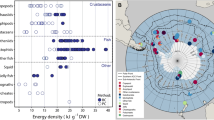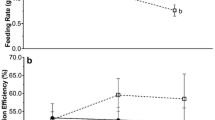Abstract
An energy budget was constructed for a population of the sea urchin Strongylocentrotus droebachiensis in the nearshore area of St. Margaret's Bay, Nova Scotia, Canada. Of the 6 age classes identified, ages 1+and 2+accounted for about 1/2 the population energy flow. Population production efficiencies were: production/assimilation=0.28, production/consumption=0.04 to 0.13, and production/biomass=0.80. Although S. droebachiensis was the dominant herbivore in the seaweed bed, it utilized only 1 to 7% of seaweed production. As with other populations of sea urchins, however, it had a proportionately greater influence on seaweed biomass, and also presumably production, by clearing seaweed from large areas of substrate and maintaining it clear. Loss of dissolved organic matter, the only term in the energy budget not measured, was estimated by substracting the other terms in the energy budget from consumption. In laboratory individuals, this ranged from 40 to 80% of absorption (consumption-faeces). A critical review of energy budgets for 6 other species of marine benthic grazers also revealed large amounts of energy unaccounted for that might be attributed to loss of dissolved organic matter.
Similar content being viewed by others
Literature Cited
Carefoot, T. H.: Growth and nutrition of Aplysia punctata feeding on a variety of marine algae. J. mar. biol. Ass. U.K. 47, 565–589 (1967).
Carpenter, J. H.: The Chesapeake Bay Institute technique for the Winkler dissolved oxygen analysis. Limnol. Oceanogr. 10, 141–143 (1965).
Conover, R. J.: Oceanography of Long Island Sound, 1952–1954. VI. Biology of Acartia clausi and A. tonsa. Bull. Bingham oceanogr. Coll. 56, 156–233 (1956).
Dickie, L. M.: Food chains and fish production, ICNAF Special publication no. 8. (1972).
Edwards, G. A. and L. Irving: The influence of temperature and season on the oxygen consumption of the sandcrab, Emerita talpoida Say. J. cell. comp. Physiol. 21, 169–182 (1943).
Edwards, R. R. C., J. H. S. Blaxter, U. K. Gopalan and C. V. Mathew: A comparison of standard oxygen consumption of temperate and tropical bottom-living marine fish. Comp. Biochem. Physiol. 34, 491–495 (1970).
Fuji, A.: Ecological studies on the growth and food consumption of Japanese common littoral sea urchin, Strongylocentrotus intermedius (A. Agassiz). Mem. Fac. Fish. Hokkaido Univ. 15, 83–160 (1967).
— and K. Kawamura: Studies on the biology of the sea urchin—VII. bioeconomics of the population of Strongylocentrotus intermedius on a rocky shore of southern Hokkaido. Bull. Jap. Soc. scient. Fish. 36, 763–775 (1970).
Giese, A. C., A. Farmanfarmaian, S. Hilden and P. Doezema: Respiration during the reproductive cycle in the sea urchin Strongylocentrotus purpuratus. Biol. Bull. mar. biol. Lab., Woods Hole 130, 192–201 (1966).
Halcrow, K. and C. M. Boyd: The oxygen consumption and swimming activity of the amphipod Gammarus oceanus. Comp. Biochem. Physiol. 23, 233–242 (1967).
Hargrave, B. T.: An energy budget for a deposit-feeding amphipod. Limnol. Oceanogr. 16, 99–103 (1971).
Haugaard, N. and L. Irving: The influence of temperature upon the oxygen consumption of the cunner (Tautogolabrus adspersus Walbaum) in summer and winter. J. cell. comp. Physiol. 21, 19–26 (1943).
Hughes, R. N.: An energy budget for a tidal-flat population of the bivalve Scrobicularia plana (DaCosta). J. Anim. Ecol. 39, 357–381 (1970).
—: Ecological energetics of the keyhole limpet Fissurella barbadensis Gmelin. J. exp. mar. Biol. Ecol. 6, 167–178 (1971a).
—: Ecological energetics of Nerita (Archaeogastropoda, Neritacea) populations on Barbados, West Indies. Mar. Biol. 11, 12–22 (1971b).
Ivlev, V.S.: Eine Mikromethode zur Bestimmung des Kaloriengehalt von Nährstoffen. Biochem. Z. 275, 49–55 (1934).
Jensen, M.: Age determination of echinoids. Sarsia 37, 41–44 (1969).
Johannes, R. E. and M. Satomi: Measuring organic matter retained by aquatic invertebrates. J. Fish. Res. Bd Can. 24, 2467–2470 (1967).
Johansen, K. and R. L. Vadas: Oxygen uptake and responses to respiratory stress in sea urchins. Biol. Bull. mar. biol. Lab., Woods Hole 132, 16–22 (1967).
Kuenzler, E. J.: Structure and energy flow of a mussel population in a Georgia salt marsh. Limnol. Oceanogr. 6, 191–204 (1961).
Leighton, D. L.: A comparative study of food selection and nutrition in the abalone, Haliotis rufescens Swainson, and the sea urchin, Strongylocentrotus purpuratus (Stimpson). Ph. D. thesis, 197 pp. University of California, San Diego 1968.
McLeese, D. W. and D. G. Wilder: The activity and catchability of the lobster (Homarus americanus) in relation to temperature. J. Fish. Res. Bd Can. 15, 1345–1354 (1958).
McNeill, S. and J. H. Lawton: Annual production and respiration in animal populations. Nature, Lond. 225, 472–474 (1970).
Mann, K. H.: Energy transformations by a population of fish in the River Thames. J. Anim. Ecol. 34, 253–275 (1965).
—: Ecological energetics of the seaweed zone in a marine bay on the Atlantic coast of Canada. I. Zonation and biomass of seaweeds. Mar. Biol. 12, 1–10 (1972a).
—: The ecological energetics of the seaweed zone in a marine bay on the Atlantic coast of Canada. II. Productivity of the seaweeds. Mar. Biol. 14, 199–209 (1972b).
— and P. A. Breen: The relation between lobster abundance and kelp forests. J. Fish. Res. Bd Can. 29, 603–605 (1972).
Marshall, S. M., A. G. Nicholls and A. P. Orr: On the biology of Calanus finmarchicus. Part VI. Oxygen consumption in relation to environmental conditions. J. mar. biol. Ass. U.K. 20, 1–27 (1935).
Mathias, J. A.: Population energetics of two amphipod species in Marion Lake. M. S. thesis, 74 pp. University of British Columbia, Vancouver (1967).
Miller, R. J., K. H. Mann and D. J. Scarratt: Production potential of a seaweed-lobster community in eastern Canada. J. Fish. Res. Bd Can. 28, 1733–1738 (1971).
Moore, H. B.: A comparison of the biology of Echinus esculentus in different habitats. Part II. J. mar. biol. Ass. U.K. 20, 109–128 (1935).
— and B. F. McPherson: A contribution to the study of productivity of the urchins Tripneustes esculentus and Lytechinus variegatus. Bull. mar. Sci. 15, 855–871 (1965).
Newell, R. C. and V. I. Pye: Seasonal changes in the effect of temperature on the oxygen consumption of the winkle Littorina littorea (L.) and the mussel Mytilus edulis L. Comp. Biochem. Physiol. 34, 367–383 (1970).
Odum, H. T. and A. E. Smalley: Comparison of population energy flow of a herbivorous and a deposit-feeding invertebrate in a salt marsh ecosystem. Proc. natn. Acad. Sci. USA 45, 617–622 (1959).
Ogino, C. and N. Kato: Studies on the nutrition of abalone—II. Protein requirements for growth of abalone, Haliotis discus. Bull. Jap. Soc. scient. Fish. 30, 523–526 (1964).
Paine, R. T.: Ash and calorie determination of sponge and opisthobranch tissues. Ecology 45, 384–387 (1964).
—: Endothermy in bomb calorimetry. Limnol. Oceanogr. 11, 126–129 (1966).
—: Energy flow in natural populations of the herbivorous gastropod Tegula funebralis. Limnol. Oceanogr. 16, 86–98 (1971).
Paranjape, M. A.: Molting and respiration of euphausiids. J. Fish. Res. Bd Can. 24, 1229–1240 (1967).
Pearce, J. S., M. E. Clark, D. L. Leighton, C. T. Mitchell and W. J. North: Marine waste disposal and sea urchin ecology. In: Annal Report of the Kelp Habitat Improvement Project 1969–1970, 172 pp. California Institute of Technology, Los Angeles 1970.
Petrusewicz, K. and A. MacFadyen: IBP Handbook No. 13. Productivity of terrestrial animals, principles and methods, 190 pp. Oxford: Blackwell 1970.
Ricker, W. E., Ed.: IBP Handbook No. 3. Methods for assessment of fish production in fresh waters, 313 pp. Oxford: Blackwell 1968.
Russell-Hunter, W. D.: Aquatic productivity: an introduction to some basic aspects of biological oceanography and limnology, 306 pp. London: Collier-Macmillan 1970.
Saunders, R. L.: Respiration of the Atlantic cod. J. Fish. Res. Bd Can. 20, 373–386 (1963).
Taylor, B. J. R.: The analysis of polymodal frequency distributions. J. Anim. Ecol. 34, 445–452 (1965).
Author information
Authors and Affiliations
Additional information
Communicated by T. R. Parsons, Vancouver
Contribution to the International Biological Program CCIBP 192
Bedford Institute Contribution.
Rights and permissions
About this article
Cite this article
Miller, R.J., Mann, K.H. Ecological energetics of the seaweed zone in a marine bay on the Atlantic coast of Canada. III. Energy transformations by sea urchins. Marine Biology 18, 99–114 (1973). https://doi.org/10.1007/BF00348685
Accepted:
Issue Date:
DOI: https://doi.org/10.1007/BF00348685




